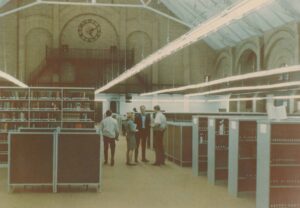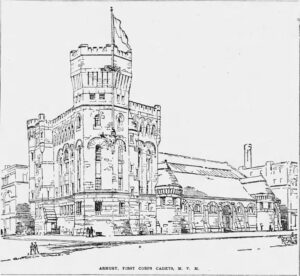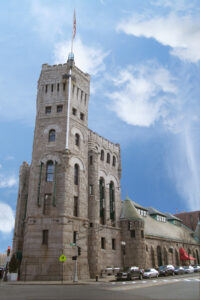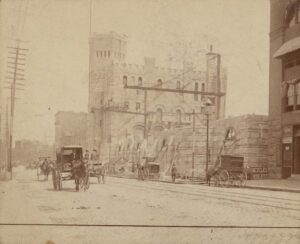Situated in Boston’s Back Bay is a particularly unique and beautiful building known by a few different names. I know it as the Armory—to others, it’s the Castle at Park Plaza. It sits at the intersections of Columbus Ave and Arlington St, looking like a relic of the past: a medieval fortress surrounded by tall office buildings, skyscraping hotels and trendy restaurants (looking at you, Salt Bae). Today, the building is lost in the skyline. When it was built in 1897, however, it stood proud and at attention for the cadets who used it.
The Armory (or Castle) was originally constructed as the headquarters for the First Corps of Cadets of the Massachusetts Volunteer Militia. If you have never heard of this before, it is because it no longer exists as it once did. The corps was reorganized and ultimately became part of the U.S. military—a relic of a bygone era.
In the wake of the Civil War, Massachusetts legislators and residents realize that they needed a prepared and well-equipped militia or volunteer corps for the practical purposes of defense and emergency management. At the same time, membership of the First Corps of Cadets had begun to wane, along with its historic luster. The Corps had a rich history as the ceremonial bodyguard of the Massachusetts governor—think elaborate military parades with colorful uniforms, flags, and a marching band. The corps also supplied officers to the regular army throughout America’s conflicts. It served as a method of networking among Boston’s young elite, with men like John Hancock serving as seated officers.
By the 1870s, the Corps needed a resurgence in both membership and relevance. They were able to raise enough money to finance the construction of a new, impressive armory. They made plans to construct this new armory in Boston, where it could be seen by the city’s ever-growing population.
The results of the Corps’ fundraising paid off in 1897, when their armory was constructed. It was designed to be used as a functioning armory as well as a headquarters for the First Corps of Cadets. Inside was a drill hall, library, rooms for the cadets, and spaces to display the Corps’ illustrious history. The building served in this capacity throughout the turn of the century. By 1965 it was still in use, and additionally served as headquarters for two Massachusetts national guard units: the 220th Infantry and Company C of the 114th Medical Battalion.
 Patrons or staff standing in UMass Boston's library in Park Square, ca. 1967. Source: UMass Boston Healy Library.
Patrons or staff standing in UMass Boston's library in Park Square, ca. 1967. Source: UMass Boston Healy Library.
By the middle of the 20th century, however, the Corps was unable to pay for the taxes or repairs on the armory. Their fundraising could no longer keep up with the costs of operating the building. The Corps decided to sell the armory to Boston real estate developer William J Fitzgerald. There were fears that, after this sale, the armory would be demolished, as Fitzgerald had a reputation as the “Parking Lot King” of Boston, and it was difficult to find an appropriate tenant for the building. Fitzgerald, however, had no preexisting plans for the building and fortunately recognized its historic value. In 1967, he leased the building to the newly created UMass Boston for use as a library in their Park Square campus. UMass Boston continued to use the armory as a library until 1974, when they relocated their main campus to Columbia Point. The Armory was listed on the National Register of Historic Places on 22 May 1973.
 Sketch of the Armory. Source: The Boston Globe, “150 Years Old: Birthday Celebration of the First Corps of Cadets,” 18 October 1891.
Sketch of the Armory. Source: The Boston Globe, “150 Years Old: Birthday Celebration of the First Corps of Cadets,” 18 October 1891.
After UMass Boston moved out, it was used as a celebratory venue for the Boston 200 exhibit in 1976. By 1977, William J Fitzgerald was looking to sell the building. At the same time, the Boston Landmarks Commission sought to designate the Armory as a historical landmark. The designation as a historical landmark faced no opposition and was approved 10 May 1977. Fitzgerald sold the building to Saunders Real Estate in 1977, which remains the owner to this day. Today, the Armory is often used as a space for traveling exhibitions and is rented to businesses that can take advantage of its old-world aesthetic.
Whether historic buildings such as the Armory are preserved often comes down to a debate between purpose and practicality. It can be easy to forget that these structures are not always protected, and come with the same responsibilities that any other building would have. They have rental costs, maintenance costs, real estate taxes, and a host of other real factors that can influence how and whether they continue to exist. Sometimes, as with the Armory in Boston’s Back Bay, these buildings are able to survive the debates and find a new purpose in a new era.
Sources
Newman, William A and Holton, Wilfred E. Boston’s Back Bay: The Story of America’s Greatest Nineteenth-Century Landfill Project . Boston: Northeastern University Press, 2006.
The Boston Globe . “150 Years Old: Birthday Celebration of the First Corps of Cadets,” 18 October 1891. 23. Viewed on Newspapers.com.
Boston Landmarks Commission. Study Report of the Boston Landmarks Commission on the potential designation of The Armory of the First Corps of Cadets as a Landmark under Chapter 772 of the Acts of 1975 . Boston: Boston Public Library, 1975.
Kline, Nat L. The Boston Globe. “Will 1st Corps Cadets Armory Surrender to Wrecking Ball?” 14 December 1965. 23. Viewed on Newspapers.com.
The Boston Globe . “1st Corps Votes Sale of Armory.” 15 December 1965. 20. Viewed on Newspapers.com.
Boston Landmarks Commission. Public Hearing on the Armory of the First Corps of Cadets, 130 Columbus Avenue and 97-105 Arlington Street . Boston: Boston Public Library, 1977.
Massachusetts Historical Commission Report for the Armory of the First Corps of Cadets. Accessed via the Massachusetts Cultural Resource Information Center: https://mhc-macris.net/#!/details?mhcid=BOS.2371
Trustees of John Simmons to Veteran Association for the Independent Corps of Cadets (1882) deed, Suffolk Co, MA Records of deeds, 1639-1885; indexes to deeds, 1639-1920. Vol 1557 Pages 340-342. Viewed on FamilySearch.org.
Digital Commonwealth Image Library
UMass Boston Healey Library
Share this:

About Raymond Addison
Raymond earned his BA in History from Stonehill College. During his time there he worked as an archivist's aide. He took roles in digitizing record collections and in preserving and restoring 19th century business ledgers. Prior to working with NEHGS, he worked with the Cambridge Public Library as a circulation librarian. He began studying his own genealogy as a hobby and quickly started showing library users how they could explore the field for themselves. In addition to his genealogical interests, Raymond enjoys being active in his free time and is an avid tennis player.View all posts by Raymond Addison →

